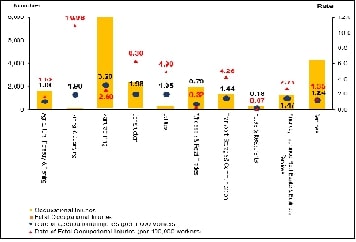Enhancing Safety Induction Programs in Malaysia’s Oil and Gas Sector: A Comprehensive Review of Best Practices and Strategic Recommendations

Abstract:
The study highlights the
crucial role of leveraging advanced technologies, such as multimedia
presentations and interactive simulations, in enhancing engagement and
retention within safety training programs. This research involved a
comprehensive analysis of participants from various job roles in the oil and
gas sector, ensuring a diverse and representative perspective on the impact of
these programs. The findings emphasize the necessity of optimizing
technological integration, catering to diverse learning styles, and
implementing mentorship systems to facilitate new employees' seamless
integration into the safety culture. Additionally, the study underscores the
effectiveness of regular safety challenges and quizzes in reinforcing critical
safety concepts and promoting continuous learning. The analysis reveals significant
positive correlations between several key factors: program design and employee
engagement (r = 0.582, p < 0.001), organizational support and overall
satisfaction (r = 0.645, p < 0.001), and participant characteristics and
information retention (r = 0.489, p < 0.001). These results demonstrate the
importance of well-structured, engaging, and interactive safety induction
programs, supported by a strong commitment from the organization. The study
provides actionable recommendations for enhancing the effectiveness of these
programs, aiming to improve safety performance, increase employee satisfaction,
and reduce the incidence of workplace accidents and injuries. Ultimately, this
research offers valuable insights into best practices for the development and enhancement
of safety induction programs, which are essential for fostering a robust safety
culture within organizations. Continuous improvement of these programs is vital
for protecting employees, enhancing operational efficiency, and contributing to
the organization's overall success.
References:
[1]. Abeni, E. A. 2020, Andragogy: A Theory in Practice in Higher
Education. Journal of Research in Higher Education, 4(2), 54–69, https://doi.org/10.24193/jrhe.2020.2.4
[2].
Arbin,
K., Frostenson, M., Helin, S., & Borglund, T., 2021, Explaining workers’
resistance against a health and safety programme: An understanding based on
hierarchical and social accountability. Safety Science, 136, 105131, https://doi.org/10.1016/j.ssci.2020.105131
[3].
Brkić,
D., & Praks, P., 2021, Offshore oil and gas safety: Protection against
explosions. Journal of Marine Science and Engineering, 9(3), 331. https://doi.org/10.3390/jmse9030331
[4].
Choudhry,
R. M., & Fang, D., 2008, Why operatives engage in unsafe work behavior:
Investigating factors on construction sites. Safety Science, 46(4),
566-584. https://doi.org/10.1016/j.ssci.2007.06.027
[5].
Department
of Statistics Malaysia, 2022, Big data analytics: National occupational
accident and disease statistics 2021. Retrieved from https://www.dosm.gov.my/portal-main/release-content/big-data-analytics-national-occupational-accident-and-disease-statistics-2021-
[6].
Hutchinson,
F. E., & Bhattacharya, J., 2022, Malaysia’s oil and gas sector: Challenges
and opportunities. ISEAS Perspective, 2022(21). Retrieved from https://www.iseas.edu.sg/wp-content/uploads/2022/01/ISEAS_Perspective_2022_21.pdf
[7].
Mayhew,
C., Quintan, M., & Ferris, R., 1997, The effects of
subcontracting/outsourcing on occupational health and safety: Survey evidence
from four Australian industries. Safety Science, 25(1-3), 163-178. https://doi.org/10.1016/S0925-7535(97)00014-3
[8]. McGrath, V., 2009, Reviewing the Evidence on How Adult
Students Learn: An Examination of Knowles’ Model of Andragogy. Adult Learner: The
Irish Journal of Adult and Community Education, 99–110. https://doi.org/10.1080/07377363.2011.614887
[9].
Mullins,
F., Blair, A., & Dunlap, K., 2019, Employee engagement in safety
procedures: The role of safety training. Journal of Safety Research, 70,
79-86. https://doi.org/10.1016/j.jsr.2019.04.005
[10]. Obong, M. M., Amadi, C., Ekpenyong,
O. E., Harry, E. W., & Edodi, H. U., 2021, Influence of health and safety
training, safety monitoring and enforcement of compliance on employee
efficiency in manufacturing firms. Research in World Economy, 12(2),
86-95. https://doi.org/10.5430/rwe.v12n2p86
[11]. Pinto, L., Nunes, E., & Sousa,
S., 2020, A framework to improve training and development of workers’ technical
skills: Effects on operational performance during company relocation. Procedia
Manufacturing, 51, 1806-1813. https://doi.org/10.1016/j.promfg.2020.10.251
[12]. Pui Teck, A. G., & Mohd Asmoni,
M. N. A., 2015, A review on the effectiveness of safety training methods for
Malaysia construction industry. Jurnal Teknologi, 74(2), 9-13. https://doi.org/10.11113/jt.v74.4518
[13]. Rutaihwa, A. E. B., 2013, Employee
orientation programs in Tanzania public institutions and their effects on
employee performance: The case of Ministry of Labour and Employment. A
Dissertation for Award of MScHRM degree at Mzumbe University, Morogoro.
[14]. Snell, A., 2006, Researching
onboarding best practice. Journal on Strategic HR Review, 5, 32-35. https://doi.org/10.1108/14754390680000925
[15]. Turner, S. n.d, Safety First Going Beyond Compliance. 31–33.
[16]. Tupavali, T. N., 2017, An analysis
of the influence of induction programmes on beginner teachers’ professional
development in the Erongo Region of Namibia. A Journal of Public
Administration, 2, 120-156.
[17]. Vecchio-Sadus, A. M., &
Griffiths, S., 2004, Marketing strategies for enhancing safety culture. Safety
Science, 42(7), 601-619. https://doi.org/10.1016/j.ssci.2003.11.001
[18]. Wicaksono, A., Ciptomulyono, U.,
Artana, K. B., & Irawan, Y. S., 2022, The impact of safety management on
oil and gas industry accidents. Safety Science, 135, 105145. https://doi.org/10.1016/j.ssci.2020.105145
[19]. Whitaker, S. M., Graves, R. J.,
James, M., & McCann, P., 2003, Safety with access scaffolds: Development of
a prototype decision aid based on accident analysis. Journal of Safety
Research, 34(3), 249-261. https://doi.org/10.1016/S0022-4375(03)00025-2
[20]. Zolyomi, E., & Danaj, S., 2019,
Language barriers and occupational safety and health of migrant workers. International
Journal of Occupational Safety and Health, 11(3), 31-39. https://doi.org/10.3126/ijosh.v11i3.25397

